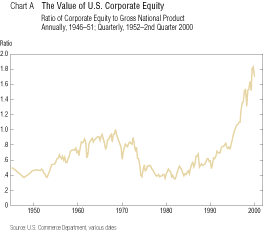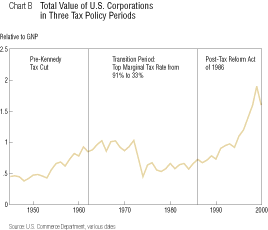With the tremendous growth in stock prices during the 1990s, and the stock market's vertiginous path over the past two years, stock investing has been a major drama of our times. Some educated observers foresee the stock market's imminent collapse and others predict a Dow of 36,000. In their fall 2000 Quarterly Review article, Minneapolis Fed senior economist Ellen McGrattan and University of Minnesota Regents' professor and Fed adviser Edward Prescott join the fray with Is the Stock Market Overvalued? The one-word answer to their titular question: No. As of the first half of 2000, they conclude, the market was properly valued—according to standard economic theory, at least.
While many estimates of market value look at current price/earnings ratios relative to historical averages, McGrattan and Prescott take a different approach. As macroeconomists, they look at the value of market equity relative to the underlying corporate productive assets for which investors, essentially, are bidding. According to economic theory, if net indebtedness is small, the value of corporate equity should equal the value of the productive assets owned by those corporations, including both domestic holdings and those held by foreign subsidiaries, and looking not only at tangible capital (buildings, equipment, inventory), but also intangible capital (the value of patents, human capital, trademarks).
In simpler terms, people should get what they pay for. Or as Warren Buffett recently said, the secret to successful investing is buying stock "when businesses sell for less in the market than they're worth."
The easiest step for McGrattan and Prescott is determining the market value of all domestic corporate equity: not the 30 stocks that comprise the Dow Jones Industrial Average, nor just the 500 in the S&P 500, but the full market. By looking at Federal Reserve Board of Governors data, they find that the value of all U.S. stock, averaged across the first two quarters of 2000, was 1.77 times gross national product (see Chart A). Adding in corporate debt levels of about 7 percent of GNP implies a total value of U.S. corporations (equity plus debt) of 1.84 times GNP.
 More difficult is calculating the other half of the equation: the value
of underlying corporate assets. In a painstaking exercise of macroeconomic
accounting, the authors calculate the value, relative to GNP, of each
piece of the jigsaw puzzle.
More difficult is calculating the other half of the equation: the value
of underlying corporate assets. In a painstaking exercise of macroeconomic
accounting, the authors calculate the value, relative to GNP, of each
piece of the jigsaw puzzle.
They begin by using national accounts data from the U.S. Department of Commerce to calculate the worth of domestic tangible capital: the sum of corporate capital stocks (.821 GNP), inventories (.161 GNP) and land (.060 GNP). Tangible corporate assets in the United States, then, are worth 1.042 times GNP.
But what about intangible capital assets like patents, or brand names like Coca-Cola? Plus, of course, the hard-to-capture worth of human capital: the unutterable value your own innate brilliance, for example. Economists have long been stymied by this measurement problem. (In fact, one recent analysis of the stock market, Valuing Wall Street, ignores the worth of intangible capital and suggests that the market is vastly overvalued.) The problem called for an ingenious solution, and McGrattan and Prescott deliver it by, in essence, going through the back door—by deriving a formula whose only unknown value is the one they seek. Simplifying the math drastically, here's their backdoor solution: The ratio of profits to capital equals the rate of return. Capital includes both tangible and intangible capital. So if you can determine an overall profit level, calculate the value of tangible capital and estimate a rate of return, you can solve for the remaining unknown: the value of intangible capital.
Using national accounts data, the authors calculate the economy's overall profits. The value of tangible capital is already in hand (1.042 GNP), as determined above. But calculating the rate of return for corporate capital is a bit trickier. McGrattan and Prescott first estimate a rate of return for noncorporate capital—capital held by households, noncorporate businesses and government—since national accounts data provide figures for profits and capital stock in that segment of the economy. Their estimate (4.1 percent) turns out to be quite close to the interest rate on inflation-protected Treasury bonds.
By assuming that this noncorporate rate of return is equal to the rate of return for both tangible and intangible capital in the corporate sector economy—since profit-maximizing managers will keep investing in one asset type until its rate of return is the same as every other—the back door is opened. With a quick bit of math, the unknown variable—the value of intangible corporate capital—is found: .415 GNP. A similar calculation yields an estimate for the value of capital of U.S. foreign subsidiaries: .382 GNP.
Adding up these three pieces that comprise the assets of U.S. corporations—domestic tangible capital, domestic intangible capital and U.S. foreign subsidiary capital—gives a sum of 1.839 GNP, which, remarkably, equals the market value of U.S. corporate stock, previously determined: 1.84 GNP.
Conclude the authors: "Corporate equity is not overvalued." As of the first half of 2000, in other words, the U.S. stock market was not exhibiting a "bubble" of irrational stockholder behavior, but instead providing a very good indication of the value of corporate assets on which investors bid. We got what we paid for.
Why was the market so low before?
If economic theory supports the current state of affairs—equity prices at historically high levels relative to GNP—what then accounts for the fact that stocks were valued so low in the past? The answer, argue McGrattan and Prescott in a second paper, lies in one of life's great certainties: Taxes.
In Taxes, Regulations, and Asset Prices, the Minneapolis Fed economists examine equity values relative to GNP in two historical periods with relatively stable tax policies: the period before the 1963 Kennedy tax cuts and the years after the Tax Reform Act of 1986. According to their estimates, the value of the stock market, compared to GNP, roughly doubled from one period to the next (see Chart B). Said differently, since World War II, stock prices rose far faster than GNP.
 One promising explanation for a doubling in equity prices relative to
GNP might be that capital became more productive over time, raising the
capital-output ratio. When they look at the underlying productive assets,
however—using the same techniques employed in the previous paper—the
authors find that the total value of tangible, intangible and foreign
capital changed little, relative to GNP.
One promising explanation for a doubling in equity prices relative to
GNP might be that capital became more productive over time, raising the
capital-output ratio. When they look at the underlying productive assets,
however—using the same techniques employed in the previous paper—the
authors find that the total value of tangible, intangible and foreign
capital changed little, relative to GNP.
But what did change—dramatically—was the rate at which distributions to shareholders (that is, dividends and stock buybacks) were taxed. The Kennedy administration reduced marginal tax rates for the highest income bracket from 91 percent to 70 percent. Reagan reduced the top rate still further, to 50 percent in 1981 and to 33 percent after 1986. Even more significant, say the authors, were regulatory changes that allowed dividend income to be sheltered from taxes in retirement accounts, including 401(k) and pension funds, which now hold over half of all corporate equity.
As effective tax rates fell, argue McGrattan and Prescott, investors recognized the increased value of stock investing. It's as if the local bully decided to stop taking a nickel out of every dime's worth of profit made at neighborhood lemonade stands: Young entrepreneurs would begin bidding up the price of lemons and sugar. Demand for equities increased and stock prices rose.
By measuring the changes in marginal tax rates, and estimating the proportion of equity returns sheltered, the authors calculate that effective tax rates fell from about 50 percent in the pre-Kennedy period to about 10 percent by the 1990s. Theoretically, that large a drop in taxes should translate into a doubling of equity prices relative to GNP—precisely what occurred.
Returns on equity
The authors also point out that tax rate changes have had a major impact on returns on equity. Total returns equal dividends plus capital gains, and the latter include both anticipated gains due to growth in productive assets and unanticipated gains due to changes in tax rates that no one could have foreseen.
In the immediate post-war period, dividend yields were high (over 3 percent) because high tax rates implied low equity prices. The growth rate in productive assets has been steady, on the order of 3 percent. And unexpected capital gains, the result of dropping tax rates, is the growth rate in equity prices due to lower taxes, roughly 2 percent. Total returns to equity, then, in the post-war period, should have equaled the sum: approximately 8 percent (3+3+2).
But now that taxes have declined substantially, and equity prices have climbed, dividend yields have decreased to about 1 percent, anticipated gains are still roughly 3 percent, and unanticipated gains due to tax changes are (by definition) 0 percent, so equity returns should, they predict, average a little over 4 percent.
A corollary of this finding relates to the equity premium, the difference between stock and bond returns. In their related Quarterly Review article, Jagannathan, McGrattan and Scherbina describe how the premium—inexplicably high in the past—has now diminished significantly, consistent with economic theory. With their analysis of tax rate changes, Prescott and McGrattan have explained that high marginal tax rates in pre-Kennedy years help account for the high equity yields of the past: Investors had to be "compensated" for the fact that their dividends would be taxed away.
But why—when stocks held the promise of much higher returns—did pension fund managers hold bonds? Indeed, pension funds held virtually no equity in the early 1960s. Why didn't they try to capture the premium?
The economists suggest that until the 1970s, pension fund managers faced unclear fiduciary liabilities that encouraged investment in debt rather than equity. When regulatory changes in the 1970s (especially the Employment Retirement Income Security Act of 1974) clarified the fiduciary responsibilities of pension administrators and provided them with more flexibility in fund allocation, they shifted heavily toward stocks.
With increased purchases of equity, and a move away from bonds, equity yields declined and bond yields increased—in inverse relationship to their prices—and the equity premium diminished.





